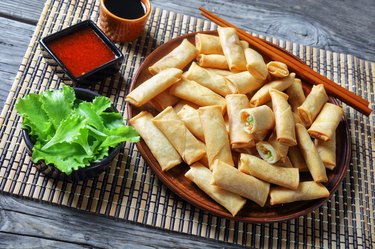
Takeout Chinese food is one of the great pleasures of modern life — and what to do with the leftovers is one of the most common quandaries. Egg rolls get their initial crispness from deep-frying. To reheat egg rolls properly, your challenge is to preserve their famous crunch.
Tackling Egg Roll Heating Instructions
Video of the Day
Your main task, when you reheat egg rolls, is to help them retain their crispy exterior, while warming their interiors to the proper temperature. No matter which reheating method you choose, following the directions closely will ensure the best success.
Video of the Day
No matter which egg roll heating instructions you choose as your method, checking the interior of a thick-skinned egg roll can be tricky without poking a hole in the shell. There's nothing wrong with slicing the egg rolls after reheating to test the doneness of the filling.
You can cut on the diagonal and drizzle with a bit of sauce to make it look more appealing. Not only should they seem hot to the touch, but they should register a minimum of 165 degrees Fahrenheit on a kitchen thermometer, according to the United States Department of Agriculture (USDA). This same internal temperature applies when you're deciding on the best way to reheat vegetable spring rolls, or those with chicken or seafood.
Oven or toaster oven: This method is the most likely to keep the exterior of the egg rolls crisp, but it is a little more time-intensive.
- Preheat the oven to 350 F, and line a baking sheet with aluminum foil.
- Set the egg rolls on the sheet. (A bit of cooking spray applied to the surface first can keep the egg rolls from sticking to the aluminum foil.)
- Put the baking sheet in the oven when it hits the proper temperature.
- Rotate the rolls about halfway through the reheating process to allow all sides to crisp up.
- Check them after about 5 minutes. They should look crisp. If not, wait another 2 to 5 minutes.
Microwave: It's much more challenging to reheat an egg roll in the microwave without losing that all-important crunchy wrapping. Using a trivet can help lessen the soggy factor; these little slotted stands often come with the microwave itself, or can be picked up at a home goods store.
- Put the trivet on a microwave-safe dish or in a microwavable bowl.
- Set the egg rolls on top of the trivet.
- Reheat on High for about 30 seconds. If the rolls have been in the fridge, they may need more time than that.
- Turn the eggrolls over, and microwave on High for another 15 to 30 seconds.
- Remove the rolls when they've achieved some crispiness, but confirm that the insides are hot before serving.
Read more: Gluten-Free Chinese Foods
Tip
The best way to reheat vegetable spring rolls is similar to the egg roll methods above. But because the wrap is more delicate and the filling less substantial, storing rolls individually wrapped in plastic can help keep them fresher when it's time to reheat. Using a slightly lower heat setting and reduced cooking time is usually the best way to reheat vegetable spring rolls.
Rolling Up Your Health Goals
Obviously, deep-fried treats, whether fresh from the restaurant, or revived as leftovers, shouldn't be more than an occasional indulgence. According to the USDA, egg rolls average about 100 to 175 calories, depending on size and filling.
How much fat each roll contains depends largely on the filling. With 9 grams of fat, a medium beef or pork egg roll has about twice the fat as a large chicken egg roll and nine times as much as a similar-sized vegetable egg roll. You can also expect 20 to 30 grams of carbohydrates, which come from the wrapping, and at least 250 milligrams of sodium.
You'll also get about 10 to 20 percent of the protein you need for the day, depending on the filling. Even veggie eggrolls can have eggs, tofu on protein-rich mushrooms, after all. The filling also dictates what other macronutrients the rolls contain, but in general meat-based fillings provide some iron, and the cabbage and carrots usually included in fillings deliver vitamin C.
Read more: List of MSG-Free Foods
To alleviate the richness of these goodies after you reheat egg rolls, consider pairing them with a green salad or steamed vegetables. You'll already be getting protein and carbohydrates from the egg rolls, but the vegetables will provide extra fiber, along with vitamins and minerals.
- Carnegie Mellon University: "Chinese Cooking techniques"
- USDA Food Safety and Inspection Service: "Leftovers and Food Safety"
- Purdue University: "Microwave Cooking Equipment and Utensils"
- USDA: "Beef or Pork Egg Roll"
- USDA: "Chicken Egg Rolls"
- USDA: "Vegetable Egg Roll"
- Taste Quest: "The Art of Reviving Leftovers"
- Regional Cancer Center: "Quinoa Spring Rolls with Cashew Dipping Sauce"